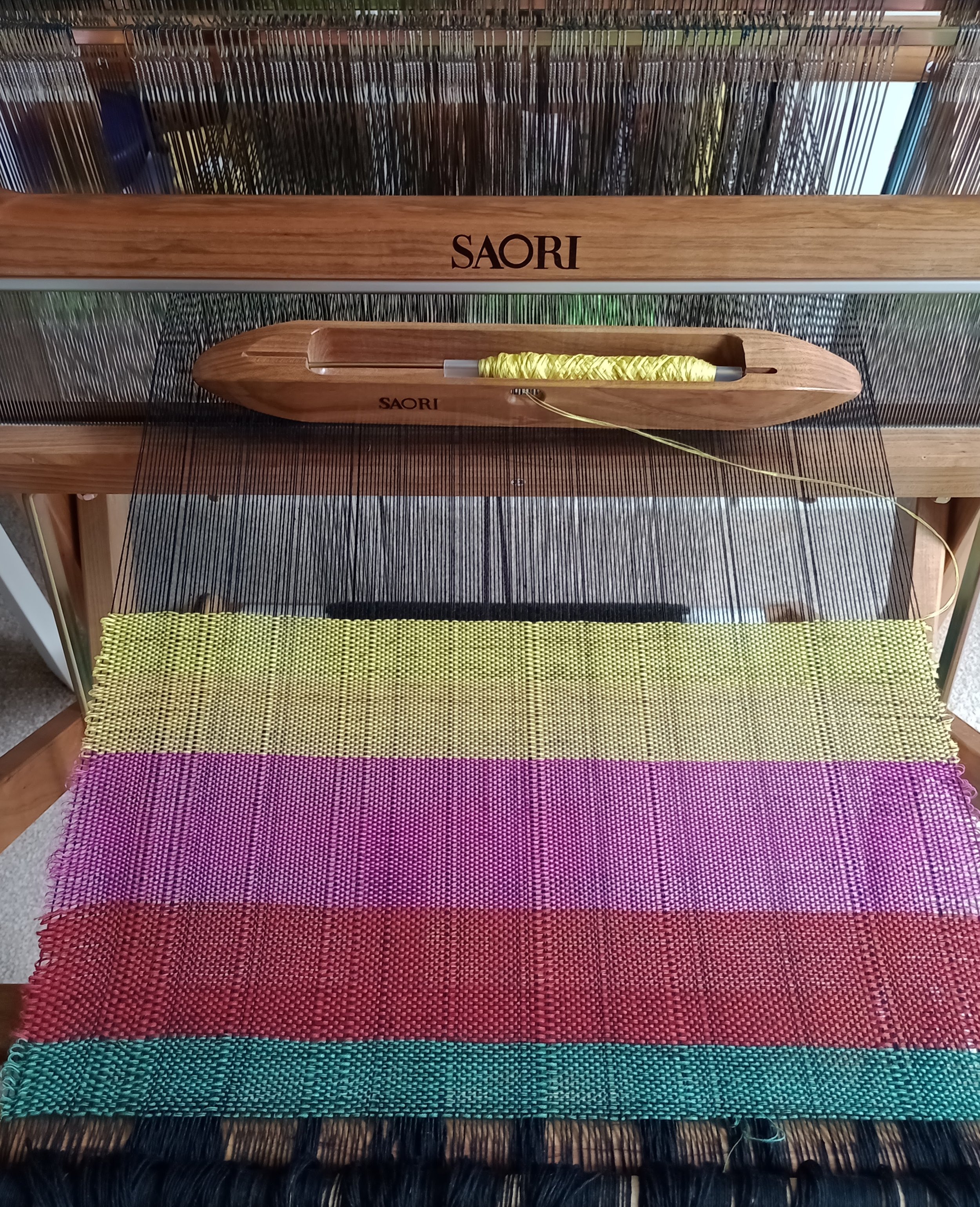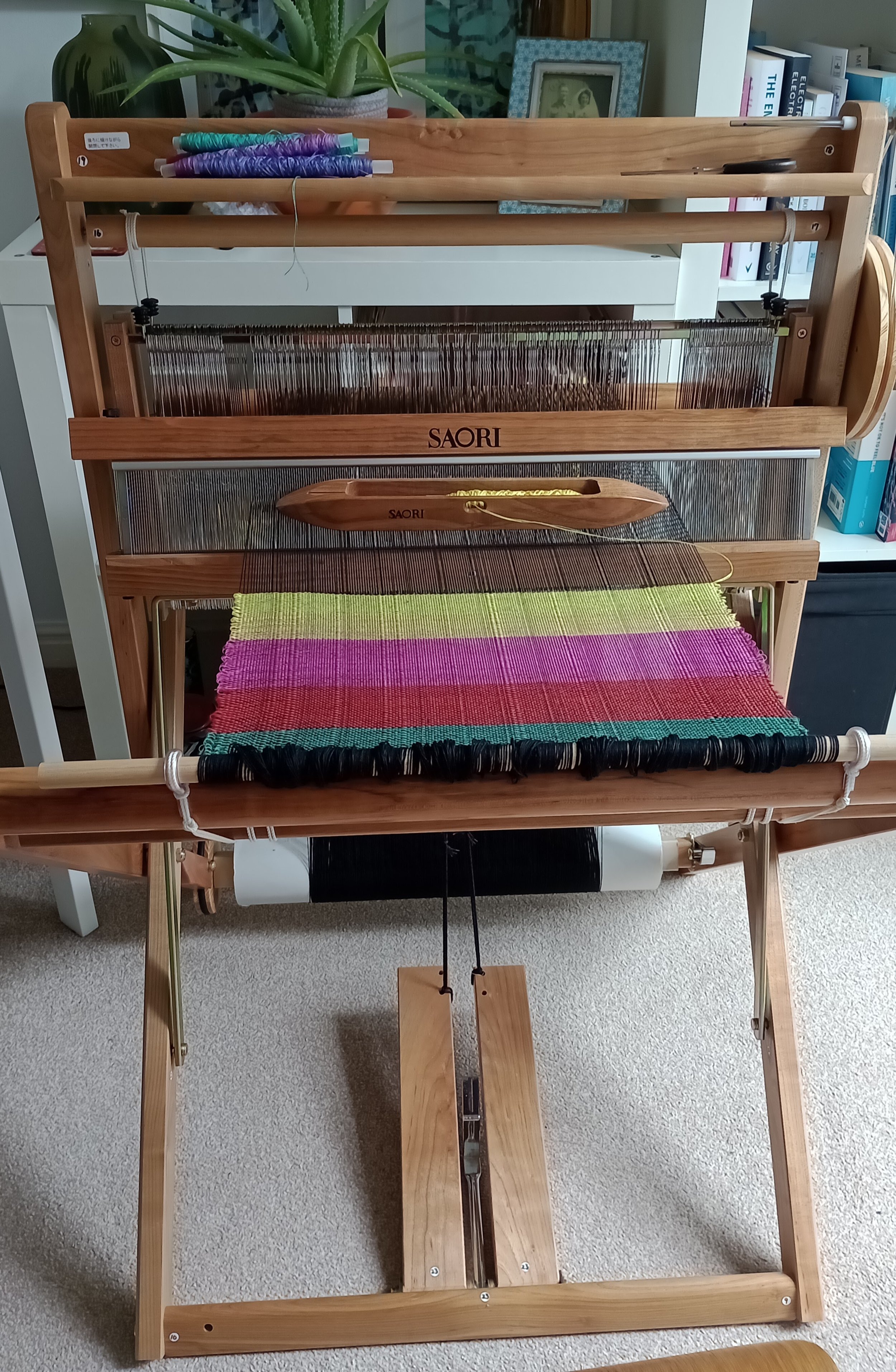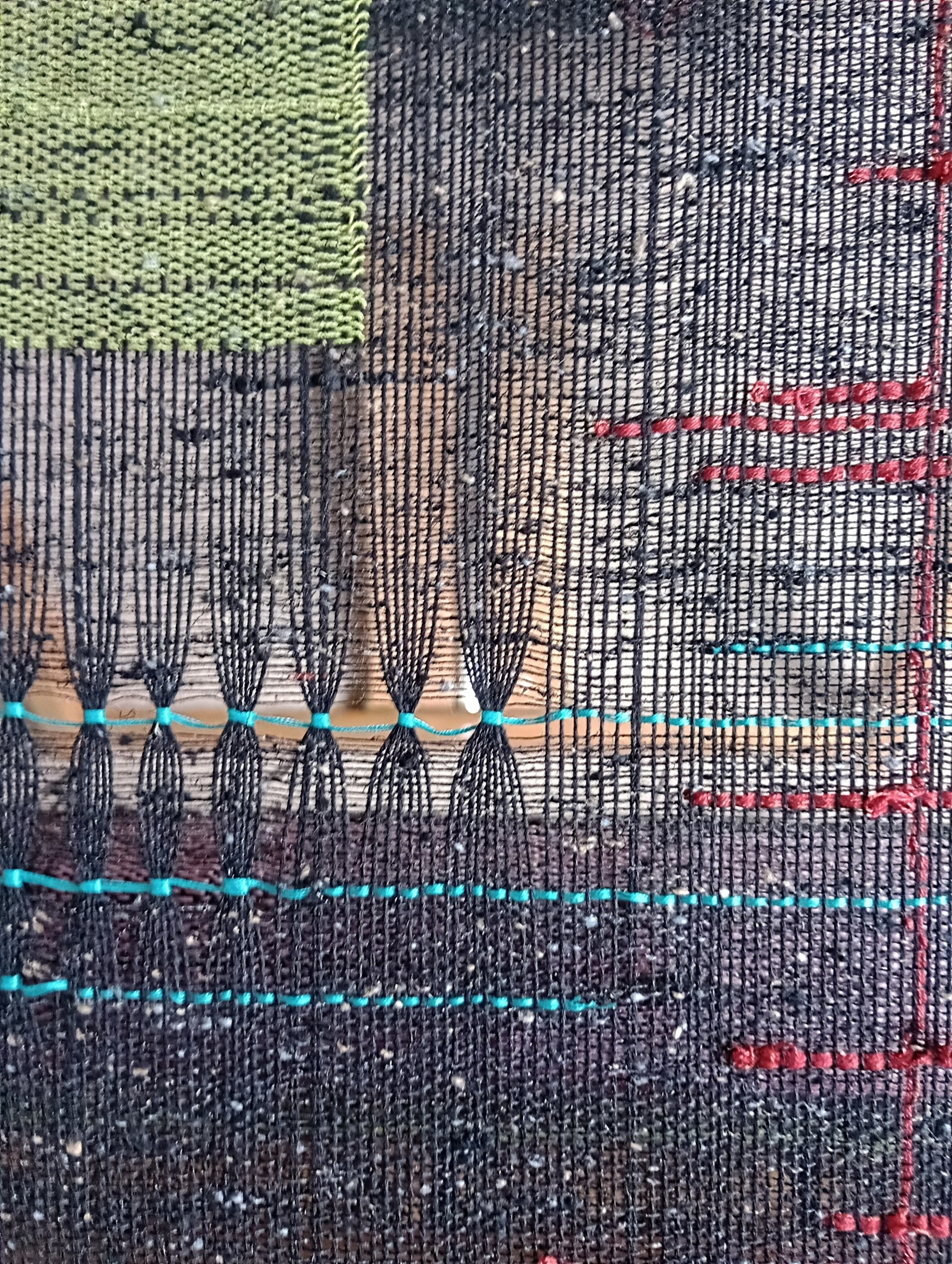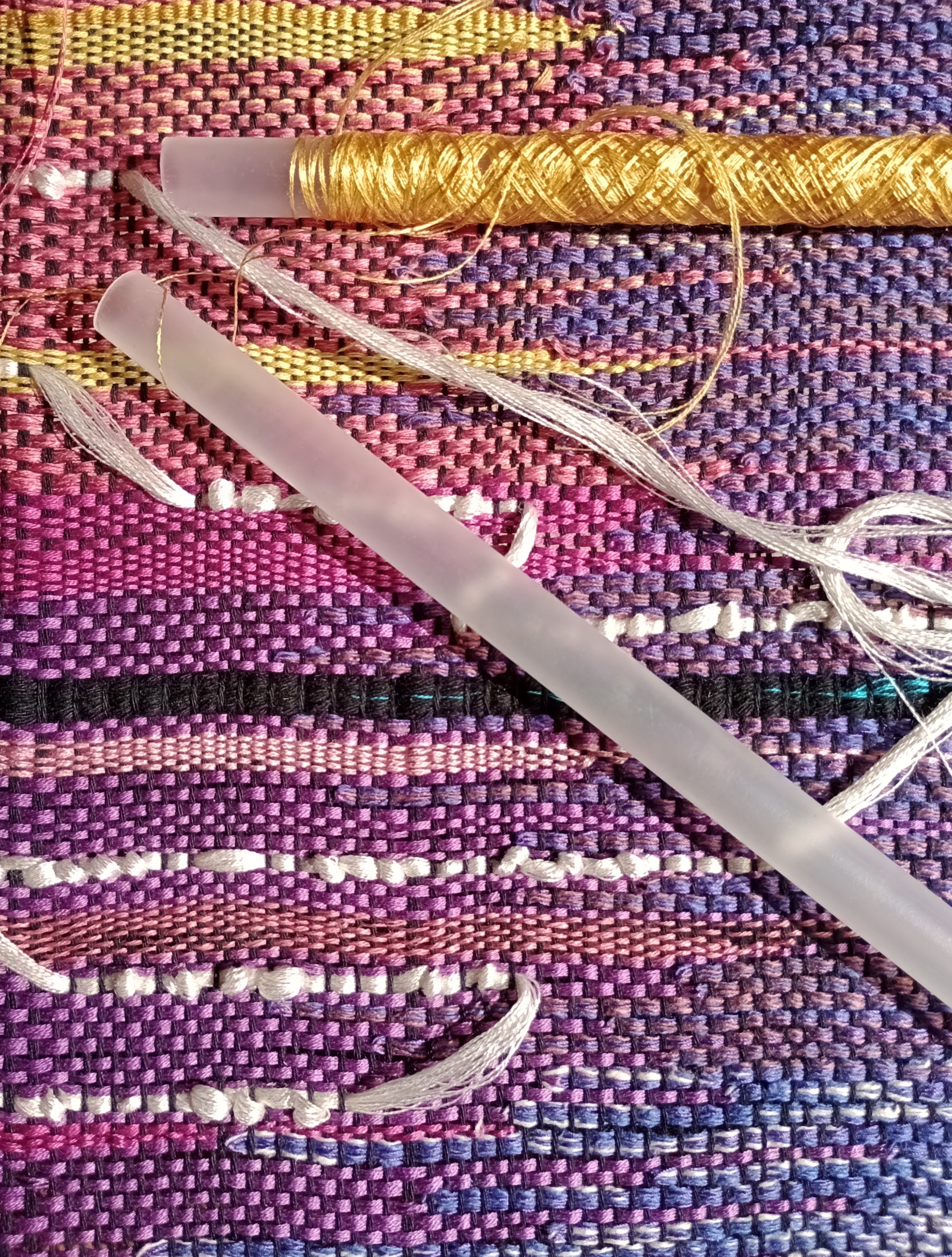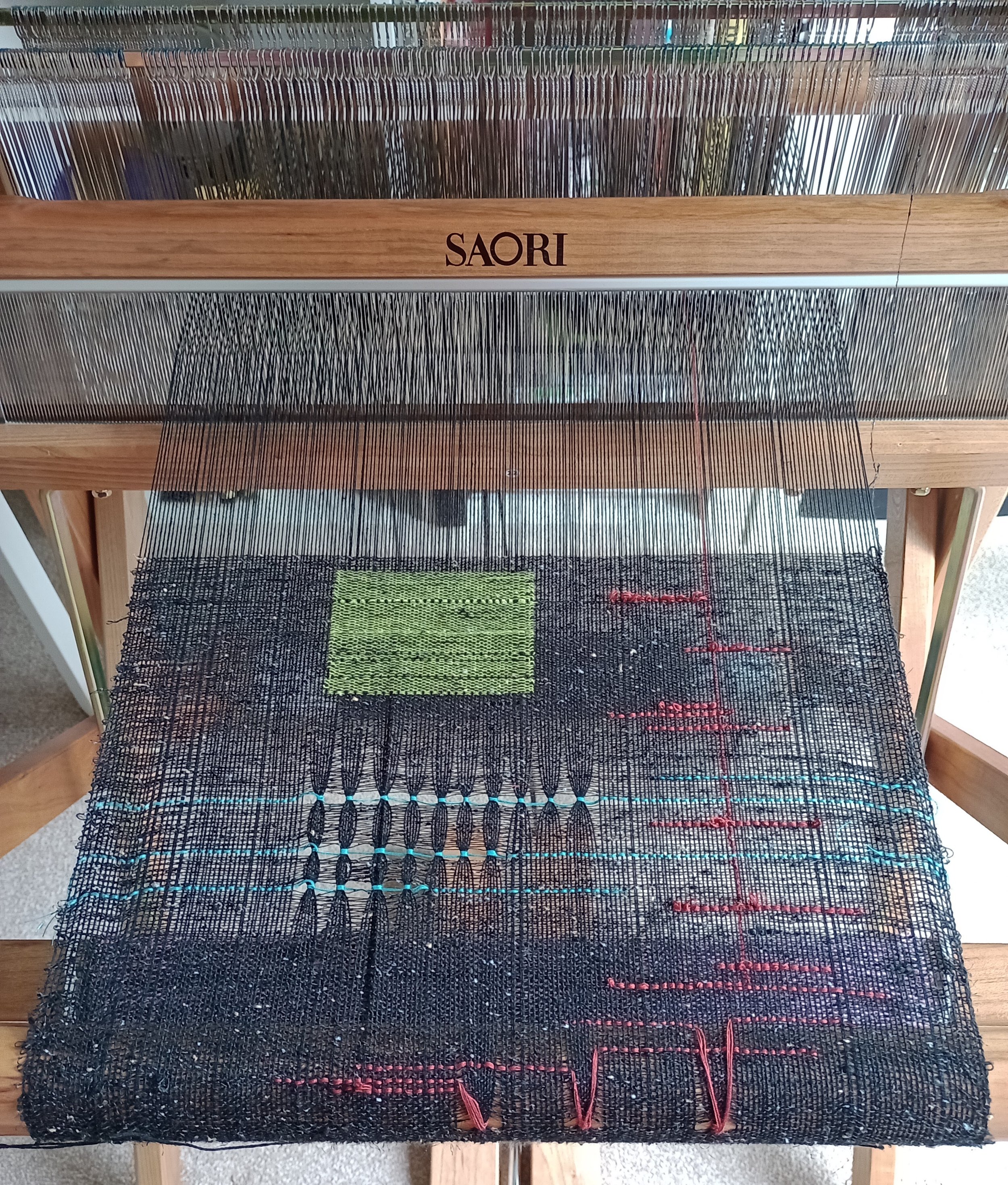I really wanted to get closer to the heart of the ethos of SAORI weaving and to understand more about the thinking of SAORI founder Misao Jo. This seemed to leave me no option but to purchase the official handbook, SAORI Self-Innovation Through Free Weaving by Misao Jo & Kenzo Jo . The book is a bit expensive and not that easy to get hold of except through registered Saori studios, however it is very extensive and contains all the vital information you could need as a serious Saori weaver.
It’s not my intention to write a book review here, but rather to pull out and share a summary of key themes and ideas that interest me about the ethos of Saori. The majority of this comes from the parts of the book written by Misao in 1977, 1989 and republished in 2000. The edition I'm reading from was first published in 2012 and printed in 2021. Misao’s writings were first published in Japanese and have been translated into English with the first English edition published in 2001. I’m mentioning this because it may affect the interpretation of certain ideas and language.
For me, two very significant themes came through which are the idea of self-expression being key to identifying and developing our ‘true-selves’ and the idea of ‘Kansei’ which refers to an innate sense of intuitive beauty inherent in everyone. These are two themes I very much want to develop further in my own work.
Other themes emerged which in no particular order, I categorised as, Humans Vs Machines, Human Nature, Unconventional Thinking, Failure and ‘Mistakes’, The Innocent Mind, Self-Expression in the Creative Process and The True-Self, Intuition, Present moment, Process over Product, Spirituality, Developing Creativity Vs Teaching and The Path I (Misao) Followed. Some of these are very strong themes in Saori, some I’ve picked out in a search to make links between Saori and my ideas around intuition in the creative process. These ideas have been clarified recently by reading the article Understanding creative intuition by Theresa Jane Hardman. I intend to compare these ideas in more depth in the future but not today!
Of course SAORI has its key statements and themes expressed in it’s four slogans
Four Slogans of SAORI (1975) p142
Consider the difference between a machine and a human being
Be bold and adventurous
Look out through eyes that shine
Inspire one another, and everyone in the group.
These are not my main focus in writing this, but I think it is important to acknowledge them and also that by examining Saori ethos in more depth, to see how these slogans emerged.
SAORI Ideas and Themes
Humans Vs Machines
This is a key theme in Saori and also relates to the first of the four Slogans. Misao was very concerned with the comparison between what could be produced by machine and an industrialised weaving process in comparison to what individuals could produce in a hand weaving process.
“When I began weaving, however, I took the ‘anti-machine’ stance. With the ability to think and the ability to feel, how could people be inferior to machines? I swore that I would produce work that no machine could match, in the belief that only such work could express life.” p15
Human Nature
Saori puts an emphasis on creative self-expression related to an idea of expressing the essence of human nature. Understanding human nature allows for the understanding of your ‘true-self’.
Unconventional Thinking
Linking to the second slogan; Be bold and adventurous. Misao encouraged weavers to think unconventionally in what they created on the looms and in order to know and express more of their ‘true-selves’. She advocated for breaking away from ‘common sense’ and conventional thinking and from worrying about what other people may think and societal pressures of being ‘productive’.
“For pursuing one’s true self, it is vital to develop a free mind and the ability to accommodate the unconventional as the first step.” p14.
“The only aim of SAORI Weaving is to express our minds freely without regulations.” p16.
“In this society, I have been experiencing great difficulties everyday in changing people’s customary conventional thinking. But such a revolutionary awakening is an indispensable step for those that seek their true selves.” p140.
Failure and Mistakes
Part of the legend of Saori is the story of Misao weaving an Obi and showing it to a weaving firm owner. He pointed out a flaw in the threading and said it was worthless as a commercial piece (p135). Misao had seen this as part of the pattern rather than a flaw. From this incident Misao decided to weave ‘flaws’ on purpose to create work that could only have been handwoven. Other wisdom on this from the book is the advice ‘don’t be afraid of failure’, (p93) and that we can learn more from our failures than from teachers.
The Innocent Mind
This relates to the third slogan, Look out through eyes that shine, and links closely to ideas about unconventional thinking. An innocent mind here means the ability to express your true-self freely without any restrictions.
“An innocent mind can create inspirational work.” p18.
This is also about an emphasis on being interested in what’s around us and paying attention to beautiful things. Misao believed it was important to develop ‘aesthetic eyes’. This I think links to the idea of finding creative inspiration in beauty and nature and being open minded enough to see and be inspired by those things.
An innocent mind is also one that’s not been conditioned into conventional thinking, so this may be more evident in children than in older people. In older people it may be necessary to uncover the innocent mind within.
“SAORI Weaving is a struggle with your inner mind. However, at the same time this struggle is a fun activity because you will be able to see things that you have never seen before in this world.” p18.
Self-Expression in the Creative Process and the True-Self
“We do not weave a piece of cloth, but rather our true selves.” Misao quoted by Kenzo Jo, Preface p6.
Core to the ethos of Saori is the idea that through the ‘free weaving’ process we can access a level of self-expression. Through the process of separating from conventional thinking and developing personal creativity, something called ‘the true-self’ emerges to be expressed in and through the weaving. This development happens not just in the weaving but in the person/weaver who comes to gain a greater depth of knowledge of themselves.
“...when you are fully able to enjoy weaving without restraint or restrictions, you come to express your true self.” p90
The concept of a ‘true-self’ is taken for granted along with the idea that it is likely to be somewhat suppressed by life and conventions and that it can take work and suffering to access. This is a concept that perhaps requires more in depth investigation in itself but it is not unlike Jung’s ideas of a ‘Self’ that is hidden beneath the subconscious and that can be accessed through a process of self-individuation.
Although Saori is very concerned with the individual expressing their true-self, this is not done without placing the individual in the broader community. Developing and understanding the self leads to more understanding and respect for others. Which leads to the fourth slogan; Inspire one another, and everyone in the group.
“SAORI weaving in which you express your true self and esteem the different personalities of each individual, also develops the mind towards respect for others’ personalities.” Kenzo Jo, Preface, p7.
Intuition
Misao used the word ‘Kansei’ to refer to an intuitive sense of beauty existing inside of us that is inherent in everyone. This is another way that humans are different from machines. This Kansei is an aspect of the true-self and can be expressed through creative output when one weaves without restriction or restraint.
“In their SAORI work, the weavers’ personal histories are woven and their individualities…emerge along with their capabilities and kansei…” p140.
The other Saori characteristic that I believe links to intuition is the concept of creating ‘Beauty with lack of intention’. I think this relates to the process of weaving in the moment without pre-planned outcomes and with an emphasis on expression. So in effect the ‘beauty’ emerges naturally through the process because it originates from an intuitive, personal, sense of aesthetics.
“My spirit is alive in the fabric woven with my kansei.” p139.
Present Moment
This is about being absorbed in the moment whilst weaving. Others may refer to this as a state of flow or mindfulness. It links with the idea of connecting to the intuition through being absorbed and focused on the process. Thoughts and feelings are in essence then captured and expressed in the woven piece.
“Each weaving can capture the present moment that we can never take back.” p12.
Process over Product
It appears to me that the SAORI ethos values the creative process of weaving over the final product produced. That’s not to say that the final woven piece of work doesn’t have value, but rather that the process that values self-expression and individuality is part of its inherent value. The work is valuable because of the nature of the process, not because of the production of a product.
“We do not make an imitation, but rather a new creation.” p17.
“A product without individuality has little value.” p92.
Saori also values the creative thought process over techniques.
“In creative activities, the thought process means much more than the technique.” p17.
Nature as Influence
This theme doesn’t appear often in the book but often enough for me to think it is significant to Saori. It seems that nature and the beauty of nature was important to Misao and was something she believed to be important in the context of developing an aesthetic sensibility and developing a personal Kensai. There is also the connection to valuing human nature and the true-self as a natural being or a being connected to the natural world.
“Nature was the only thing that could serve as a model.” Kenzo Jo, Preface, p7.
“Respect our true selves through appreciating nature.” p130.
Spirituality
There is a spiritual undercurrent to Saori ideas, perhaps with a basis in Japanese Zen philosophies. Misao refers to the difficulty of achieving ‘a state of spiritual innocence’ (p92.). This state, she equates with the ability to weave and express your true-self freely, without restrictions and to be fully absorbed in the weaving process.
In the preface, Kenzo Jo describes the success of the philosophy spreading to other countries due to a global trend for ‘self-realisation’ and ‘spiritual fulfilment’ (page 7.)
Developing Creativity Vs Teaching
"We don’t teach, we develop creativity.”
This is a key tenet of SAORI philosophy especially important in the training of Saori instructors. The book is very clear that teaching in Saori should only be that of the basic techniques. The instructor's main role is to support the development of individual creativity and therefore the weavers’ individual strengths, self-expression and ‘true-self’.
“Saori-style guidance is helping learners to find their true selves and encouraging them to learn directly from their years of life experience across many situations.” p91.
The Path Misao Followed
Towards the end of the book, Misao Jo describes her life experiences and how they led her to establishing SAORI weaving. I’m including this as I think it’s important to acknowledge the founder of SAORI as the practice is based on her ideas, and shaped by her character, experiences and life journey. She was clearly a remarkable woman who interestingly only started weaving aged 57 and died in 2018 aged 104. Many of her ideas about expressing creativity, rejecting convention and valuing nature, came through her experience with Ikebana and her frustration at the constrictions of the traditional methods.
References
All quotes and page numbers refer to the book SAORI Self-Innovation Through Free Weaving by Misao Jo & Kenzo Jo, English version first published 2012, this edition printed 2021, published and printed in Japan.
Links
SAORI Self-Innovation Through Free Weaving by Misao Jo & Kenzo Jo
Understanding creative intuition by Theresa Jane Hardman.
Intuitive Threads is a personal research and development project by textile artist Amie Wiberley, Supported using public funding by Arts Council England.
If you would like to keep up to date with my progress throughout this project, please follow me on my blog and Social Media; Instagram @ameswibs, Twitter @amiwib, Facebook Amie Wiberley Textile Artist
Amie is a textile artist and holistic and creativity coach. Find out more at www.amiewiberley.co.uk. Sign up to the mailing list here.

